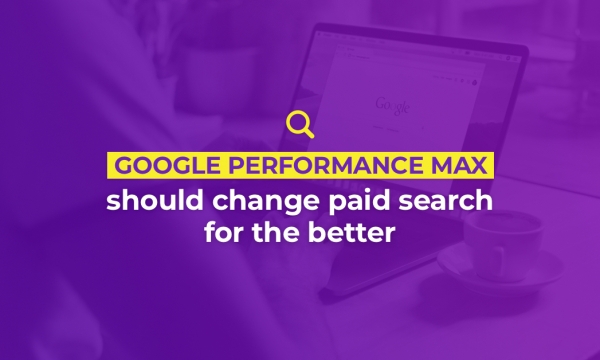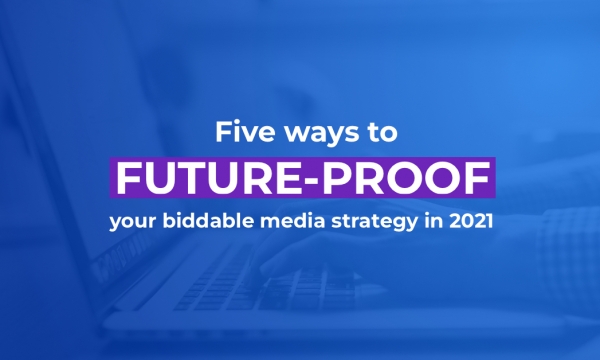There is no reason to fear the creep of automation coming to paid search. Instead, we should embrace it so that we can do what we humans do best – come up with incredible paid search strategies.
“Automation” has been something of a buzzword in the marketing world for quite some time, particularly when it comes to paid search. Search engines continue to roll out new features, often with the use of machine learning, to help make lives easier for marketers.
In recent years, we have seen several developments come to ad platforms, including:
- The expansion of close variant matching to exact match keywords, which now enables more semantic variations to match to the keywords in an ad account.
- The rise of automated bidding, with the development of robust algorithms that help to deliver target impression share, CPAs or ROAS.
- Google’s introduction of new ‘smart’ style campaigns, such as Smart Display or Smart Shopping, giving more power to AI and machine learning to optimise towards the most effective content, placements and audiences.
- Improvements in planning tools, including reach planner, keyword planner and performance planner, to help advertisers forecast with improved accuracy, based on the historical data in their accounts.
Perhaps unsurprisingly, the creep of automation has been met with a not inconsiderable degree of trepidation from marketers. Can we really trust a machine to do our job for us? What if our performance drops since we have less control over what we’re matching to, our bidding approach, and the ads we’re serving? And perhaps a scarier question still, if a machine can do all of this for us and deliver a strong performance, what happens to our roles?
So let’s try to answer those questions. If this is where the future of paid search lies, it is better for us to understand it, rather than ignore it and hope that it all goes away.
Do we actually want to do the work the machines are taking?
Let’s start by looking at the nature of the tasks now picked up by computers.
Keyword expansion, bidding, forecasting – are these really the sort of highly repetitive and time-consuming tasks that we want to be doing? Would it be the worst thing in the world to free up our time from these laborious tasks? After all, how many of us want to spend hours trawling through historical data to create a forecast, when Google Ads can help us on our way with a few simple clicks?
Even if we do want to do those sorts of tasks, what if the automation can do it better than we can? In truth, a machine processing lots of data, making real time bid changes across thousands of keywords, multiple times a day, may in fact be more effective than what we could achieve manually.
This leads us to the point where we have more time to focus on the sorts of things where human beings can actually add much more value – strategy.
How can we enhance what AI offers us?
Instead, we must ask ourselves – how can I enhance the work of these algorithms? How can we become the creator, rather than the robot? The answer, we’ve found, is data.
The algorithms that sit within Microsoft Ads and Google Ads are quite limited by their vision. They can only use the data available to them and nothing more. It’s therefore our job to feed them with the data we hold as businesses and agencies, creating even more innovative and effective means of automation. There’s a wide range of data points out there and it differs by vertical, but to name just a few we could consider:
- Margin
- Stock levels and availability
- Best sellers and popular products
- Entry products
- Pricing and promotions
- LTV
- Seasonality
- SEO rankings
- Commercial targets
If we can find a way to integrate this data into the data that the ad platforms hold, we can make much more effective campaigns. One way to do this is through the use of feeds.
Integrating data into Google Shopping feeds
Shopping campaigns are an area that have undergone intense automation over the last year with the emergence of Smart Shopping Campaigns. Unlike traditional shopping campaigns, we can no longer set campaign priorities, change bids, adjust audiences and device or create schedules. So it’s incredibly important that we improve the quality of information we send to Google in order to optimise towards our business goals. This is done through feed optimisation.
Look at developing:
- Titles - so that these are as full and relevant as possible to match to high quality search terms.
- Descriptions - to provide additional matching information for the algorithm, as well as encouraging increased user engagement.
- Product types – with consistent and granular segmentation to help with campaigns structure and reporting.
- Custom labels – these should be closely related to your business goals, so that the algorithm can optimise towards them. We’d always recommend margin, since this helps to push towards profitability, not just revenue, but some further examples are found below:
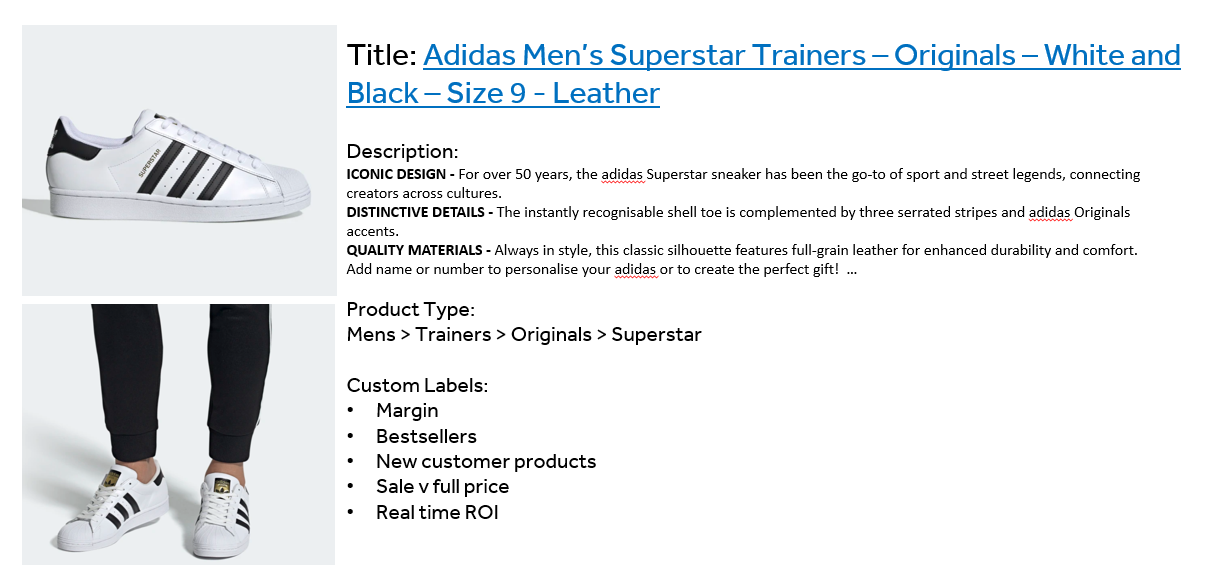
What’s more, your feed powers more than just your shopping ads. A healthy feed helps to generate improved results across YouTube, Gmail, Display and even Organic Surfaces Across Google.
Following a feed overhaul of one of our fashion retail clients, we saw a 55% increase in shopping CVR%, 60% increase in shopping revenue and 85% increase in ROI.
Integrating data into business feeds
There’s no doubt that automated bidding is incredibly effective when it comes to improving performance of our accounts. Automated bidding can make real time changes across a wealth of data using machine learning. However, as we previously mentioned, these algorithms are limited by the types of data they can see – optimising towards the standard metrics of click volume, impression share, conversions and CPA. This is where business data feeds can come in – a feature that you’ll find in bid management platforms such as Search Ads 360.
Business data tables allow us to upload additional information about our business, services or products and attribute this to our campaigns, keywords or ads. The simple example below shows a business data feed for a sports betting brand.
Here, the number of first-time deposits per sport will continually fluctuate over time but by pulling this data into SA360, we have a view of how each sport is performing for the business as a whole, beyond just paid search. Using rules, we can then create our own bidding strategies to react to changes in trends and seasonality around sports and events. Similarly, we could look to optimise towards the value of each sport to us as a business, not just the number of deposits.
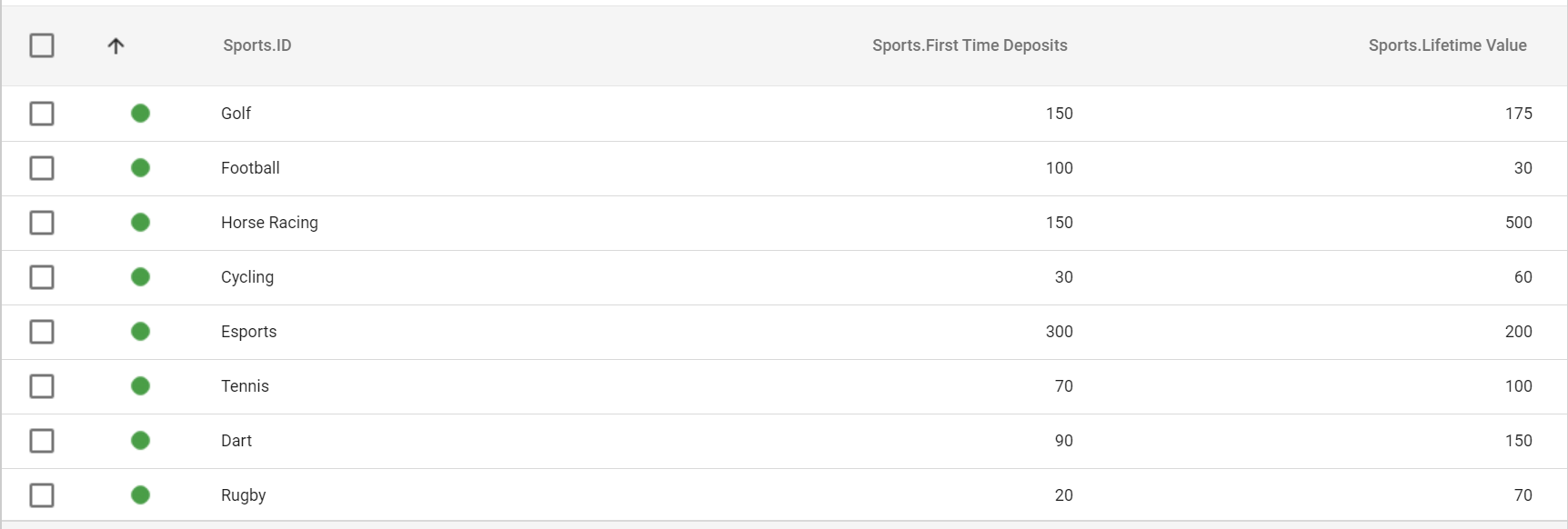
Stickyeyes has been taking this holistic approach to search by using business tables to import organic rankings and associate these back to keywords – allowing us to make smarter, holistic search optimisation rules.

Integrating data into page feeds
Perhaps one of the automated features that causes most trepidation in Google Ads is Dynamic Search Ads. Here, we’re handing over a lot of our power to the Google algorithm, allowing it not only to pick the search terms we match to, but also our ad copy headlines. Naturally, we had our reservations at first, but we were soon convinced when trialling these on our accounts in conjunction with page feeds.
There are multiple different ways to target your ads:
- Category targeting - Target users simply based on categories that are relevant for your product or service. This often returns the broadest results.
- Whole site targeting - Allow Google to match search terms that appear relevant to your entire site. Results here are relevant, but not too refined.
- Page feed targeting - Provide specific high priority pages to Google and allow Google to find search terms most relevant to these areas only.
To make this as effective as can be, ensure you select the pages on your website that most resemble your business goals. And if you’ve already got an optimised shopping feed or business data, you’ll find this is much easier to do. Simply extract URLs from your high priority custom labels in your shopping feed, or keyword final URLs that correspond to business data you’re optimising towards. Examples are below:
- Target your top margin products only to generate more profit.
- Target flights or hotels that have a higher availability to fill up those spaces.
Where we’ve used DSA on one of our energy clients, we saw a 42% reduction in CPCs compared to standard generics, 90% increase in generic volume, 12% uplift in on site engagement.
Integrating data into Ad Customiser feeds
All this data doesn’t only have to power our back-end optimisations; it can power the front end as well. This comes in the form of ad customiser feeds. If you haven’t used them before, ad customisers are dynamic parameters that enable you to create super tailored, compelling ads by pulling information from a feed in your account.
In the example below, this printing company can easily update the cost associated to the product their advertising. By pulling this information from a feed, it can be automatically updated on a regular basis – saving on time and eliminating any performance drops we may encounter from having to regularly pause ads and create new ones. They’re also able to pull in a ‘next day delivery message’ up until the cut-off point, at which time it will switch to a generic delivery CTA.
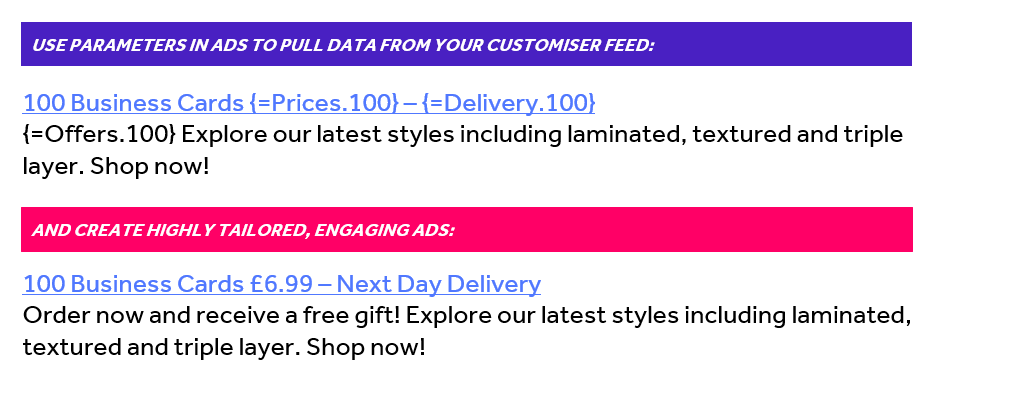
Consider the types of messaging you’d like to tailor for your campaigns, whether its your CTA, promos, prices, products, UPSs, stock levels or more!
Through the power of data and feeds, we no longer have to fear the onset of the machine. Instead, we become a part of the process, fuelling smarter and more innovative strategies than ever before!

